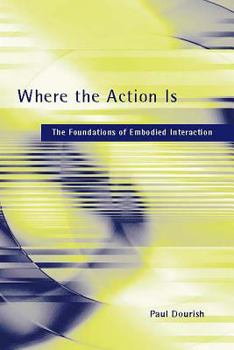Where the Action Is: The Foundations of Embodied Interaction
Select Format
Select Condition 
Book Overview
Computer science as an engineering discipline has been spectacularly successful. Yet it is also a philosophical enterprise in the way it represents the world and creates and manipulates models of reality, people, and action. In this book, Paul Dourish addresses the philosophical bases of human-computer interaction. He looks at how what he calls "embodied interaction"--an approach to interacting with software systems that emphasizes skilled, engaged...
Format:Paperback
Language:English
ISBN:0262541785
ISBN13:9780262541787
Release Date:August 2004
Publisher:MIT Press (MA)
Length:233 Pages
Weight:0.75 lbs.
Dimensions:0.5" x 5.9" x 9.0"
Age Range:18 years and up
Grade Range:Postsecondary and higher
Customer Reviews
4 ratings
Very clear, very interesting, very inspiring, but also a little like a religion
Published by Thriftbooks.com User , 16 years ago
One of the strong sides of this book is that it makes it really easy for the reader - things are generally summarised and repeated exactly in the right places. It can serve as an introduction to the world of phenomenology, sociology and philosophy as pertaining to Human-Computer Interfaces. It felt more like a mixture between a proposal and an introductory philosophical treatise than an overview of the current state of the field (it carries the word "foundations" in its title for a reason). After reading it however, I still wasn't convinced that "social computing", "tangible computing" and "embodied interaction" really add up to a construct that can effectively inform the design of new HCI devices even though this claim was repeated throughout the book almost like a prayer wheel. Interestingly, while the book points out the meaning of embodyment in already existing work practices, it fails to give any strategies on how these theories can actually be applied to the design of effective new HCI devices that go beyond the shiny toys produced at MIT Media Lab. The loophole seems to be that embodied practices can only arise once the tools are defined, so that it is hard to predict what practices will be used once it's out there - since the way we use tools is largely improvisatory, as Dourish points out. I also can not stop to wonder if the term "embodyment" is akin to "multi-media" - a belief system that can mean so many things that it effectively desintegrates sooner or later. So, while it left me not exactly sure that there really is another end to it, it was certainly worth and inspiring to work through this book in a thorough manner - I now feel courageous enough to put my nose into "Being and Time" by Heidegger. A friendly way to get your brain going!
A great book, interesting and clear
Published by Thriftbooks.com User , 16 years ago
A very interesting, and yet clear to read and follow book. "Where the action is" was a reading reference for my qualifier exam and after reading it I was hooked up to HCI forever. Very exciting and a "must read" for all HCI researchers.
Good if a little heady
Published by Thriftbooks.com User , 17 years ago
This is one of the more influential books to grace the HCI academic's shelf in recent years. Dourish's thesis, that tangible and social computing have their genesis in a sense of embeddedness in our real world and not some foreign, constructed environment known as "The OS," is stimulating material but does not dramatically change my outlook on the topic. However, it does a good job of providing useful terms and theory to support our intuition surrounding why TUIs and CSCW are useful things. I also believe that the author's goal of providing a sound philosophical and theoretical groundwork for HCI in general is a great idea, as there are few works that deliver well on this promise. As someone with limited exposure to computer-supported cooperative work before reading this book, I have to say that Dourish also has some excellent (and very readable) reviews of the most important literature in both tangible and social computing, giving a newcomer solid ground from which to consider new research.
This is a major work on the human/computer Interface
Published by Thriftbooks.com User , 22 years ago
This is a major work on the redesign of the human/computer interface. It is well written but very deep. Excellent academic research is clearly demonstrate throughout. I would not say, however, that it is an easy read. Engineering research does not generally have to be as strongly academically founded as scientific research. The controlling factor is "does it work," not how does it relate to previous work. This tendency leads to problems when it is necessary to do multidisciplinary work involving both engineering and science. The redesign of the human/computer interface is just such a problem. As an engineer working independently in this field, I have often wished for the time and resources to do proper academic studies. Paul Dourish has now done them for me. All my future publications will have to show consistency with this book, show they are clearly outside the area covered by this book, or show the book is wrong. The last alternative is most unlikely. I think I can show my work, based on Darwinism and ontology, complies with the first option. I am certain that my work will be stronger for this effort.




